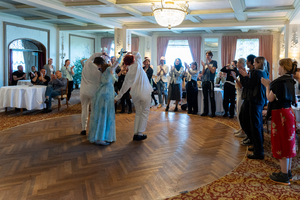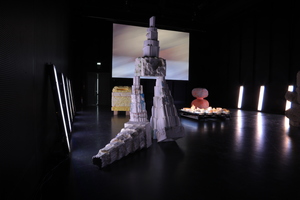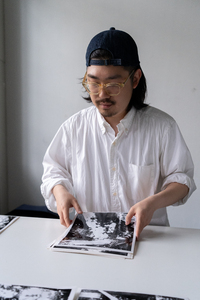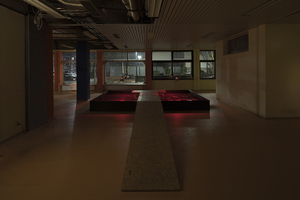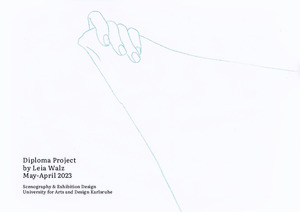Stadt als Sammlung
Benachbarte Sets (17)Alle Zusammenhänge anzeigen
Diese Sets wurden den gleichen Sets hinzugefügt wie das ausgewählte Set.
17 Inhalte
- Seite 1 von 2
Ghosts of Grand Hotels 2024
- Titel
- Ghosts of Grand Hotels 2024
- Titel (en)
- Ghosts of Grand Hotels 2024
- Untertitel
- Ausstellung der Seminararbeiten
- Beschreibung (de)
- Willkommen im Grand Hotel, liebe Passagiere! Das Reisebüro Ghostly Matters bietet Ihnen eine saisonale Fahrt durch die weite, unheilvolle Landschaft des Schwarzwalds mitten in das Herz eines ehemaligen Grandhotels: Waldlust. Seine offenen Türen verbreiten den einzigartigen Duft von Urlaub, Klassizismus, Kunst und Luxus. Entdecken Sie mit uns die unerzählten Erzählungen seiner Wände, Möbel, Küche, Mitarbeiter und Gäste, die das Internationale mit dem Lokalen verbinden. Welche Spuren hinterlassen sich nach dem Verlassen der Zimmer im Hotel? Unser Team empfängt Sie am 5. Juli in Freudenstadt zu einem außergewöhnlichen Besuch der Ausstellungsstätte Waldlust. Die kommende Ausstellung ist die Fortsetzung einer kritischen und spielerischen Auseinandersetzung mit dem Erbe und dem zeitgenössischen Status von Grand Hotels. Welche Geister verfolgen uns in den Räumen des klassizistischen und kolonialen Luxus, in den Kammern der Fürsorge und Gastfreundschaft und in den Treffpunkten von Künstlern und wohlhabendem Bürgertum? Welche Zukünfte könnten aus einem Pool verschiedener Zeitlichkeiten entstehen? Die Ausstellung ist eine Kooperation zwischen Waldlust e.V., HfG Karlsruhe, ABK Stuttgart und Hochschule Offenburg.
- Beschreibung (en)
- Welcome to Grand Hotel, dear passengers! The travel agency Ghostly Matters offers you a seasonal ride through the vast, ominous landscape of the Black Forest right into the heart of a former Grand Hotel: Waldlust. Its open doors are spreading the unique odor of holidays, classism, art and luxury. Discover with us the untold narratives of its walls, furniture, kitchen, employees and guests, that merged the international and the local. Which traces are inscribed in the hotel after the rooms are left? Our Team will welcome you on the 5th of July in Freudenstadt for a remarkable visit to the exhibition setting at Waldlust. The upcoming exhibition is the continuation of a critical and playful exploration on the legacy and contemporary status of grand hotels. Which ghosts are haunting us in the spaces of classicist and colonial luxury, the chambers of care work and hospitality and meeting places of artists and wealthy bourgeoisie? Which futures could emerge out of a pool combining various temporalities? The exhibition is a collaboration between Waldlust e.V., HfG Karlsruhe, ABK Stuttgart and Hochschule Offenburg.
- Kategorie
- Typ des Projekts/Werks
- Datierung
- 25.04.2024 - 31.07.2024
- Mitwirkende
- Ort: Institution
- Ort
- Hotel Waldlust Freudenstadt
- Stadt
- Land
- Beteiligte Institution(en)
- Titel
- Ghosts of Grand Hotels 2024
- Projektleiter/in
- Semester
- Studiengang
- Lehrveranstaltung
- Importiert am
- 22.08.2024
- Übergeordnete Sets
- 1
- Set enthält
- 0 11
Future Ruins
- Titel
- Future Ruins
- Titel (en)
- Future Ruins
- Untertitel des Projekts/Werks (en)
- Five Monuments for a Human Planet
- Autor/in
- Beschreibung (de)
- "Future Ruins" besteht aus fünf spekulativen Monumenten. Diese Modelle im menschlichen Maßstab setzen sich mit aktuellen soziologischen und geologischen Entwicklungen, mit den Werten und Idealen unserer Zeit auseinander.
- Beschreibung (en)
- "Future Ruins" consists of five speculative monuments. These human-scaled models are dealing with current sociological and geological developments, the values and ideals of our time.
- Kategorie
- Schlagworte
- Datierung
- 28.-30.06.2019
- Mitwirkende
- Material
- Abmessungen
- verschiedene Maße der Modelle
- Ort: Institution
- Ort
- Großes Studio
- Bemerkungen
- HINWEIS
Es wurden alle Anstrengungen unternommen, um die Urheberrechtsinhaber ausfindig zu machen und ihre Erlaubnis für die Verwendung von urheberrechtlich geschütztem Material einzuholen. Ich entschuldige mich für etwaige Fehler oder Auslassungen und wäre dankbar, wenn mir Korrekturen mitgeteilt würden, die in zukünftige Nachdrucke dieser Dokumentation eingearbeitet werden sollten.
DANKE
HfG Karlsruhe: Sereina Rothenberger, Rebecca Stephany, Michael Kryenbühl, Ivan Weiss, James Langdon, Yannick Nuss, Katharina Wahl, Volker Albus, Matthias Bruhn, Sebastian Schäfer, Alexander Knoppig, Tobias Keilbach, Matthias Mai, Susanne Schmitt, Susanne Trautnitz, Zaur Ahlimanov, Waldemar Schwab
Für die großzügige Unterstützung: Lisa Ertel, Felix Plachtzik, Maxim Weirich, Phil Zumbruch, Lukas Marstaller, Oliver Boualam, Marcel Strauß, Anne-Sophie Oberkrome, Philipp Schell, Christoph Hauf, Christof Hierholzer, Massimiliano Audretsch, Ute Zell, Martin Zell
- HINWEIS
- Titel
- Future Ruins
- Projektleiter/in
- Semester
- Studiengang
- Typ der Abschlussarbeit
- Importiert am
- 31.07.2024
- Übergeordnete Sets
- 0
- Set enthält
- 0 17
Dusting. Ecosystems with images and codes
- Titel
- Dusting. Ecosystems with images and codes
- Titel (en)
- Dusting. Ecosystems with images and codes
- Beschreibung (en)
- “No matter how desperately you fight against it, dust pervades everything. It accumulates in fuzzy balls or gathers in even layers, adapting to the contours of things and making the passage of time. In itself, it is also a gathering place, a random community of what has been and what is yet to be, a catalog of traces, an inventory of threats, and a set of promises… “ Michael Marder, “Dust” 2016 In this seminar we will look at different situations with images and codes where dust engages as a medium to understand the complex interrelation between the content of an image and its making, its meta-data and its technological and ecological being in the world. The seminare is practical as well as theoretical. We will dust together, and we will wait for dust to settle: on paper, in space, in our minds, and we will research and engage in dust experiments together: from field trips to laboratory visit to exhibition visits. At the end of the seminar the aim is to have delevoped a presentation, be it an image series, an installation, or/ and a research exhibition. This will be presented during the Rundgang. Prof. Susanne Kriemann organises an excursion to Vienna 24th to 27th of April to see the exhibition “Into the Woods” at KunstHausWien and the first “Klima-Biennale”.
- Typ des Projekts/Werks
- Datierung
- 30.04.2024 - 16.07.2024
- Titel
- Dusting. Ecosystems with images and codes
- Projektleiter/in
- Semester
- Studiengang
- Importiert am
- 22.08.2024
- Übergeordnete Sets
- 1
- Set enthält
- 0 25
Bildkompost
- Titel
- Bildkompost
- Autor/in
- Beschreibung (de)
- Über einen Zeitraum von vier Wochen führte Ulf Beck in einer Versuchsanordnung Fotografien aus der Tagespresse einem Kompost mit Kompostwürmern zu. Ausgehend von der Untersuchung, welche Schlagzeilen es auf die erste Seite schaffen sowie deren fotografischer Darstellung, beschäftigte er sich mit dem Nachleben dieser Bilder. Dafür schnitt er jeden Tag die Abbildungen der Titelseite dreier großer Tageszeitungen aus und legte sie in einem Raster auf ein Becken mit Komposterde.
Das fotografische Bild wird als Teil des Medienorganismus durch die Verdauung der Würmer und verschiedener Mikroorganismen innerhalb von ca. 15 Tagen in den Erdorganismus überführt. Der Transformationsprozess ist am Ende nicht mehr sichtbar. Das Bild verliert seine Form und wird zu wertvollem Humus, welcher als Ansammlung von Millionen von Mikrobildern betrachtet werden kann.
- Über einen Zeitraum von vier Wochen führte Ulf Beck in einer Versuchsanordnung Fotografien aus der Tagespresse einem Kompost mit Kompostwürmern zu. Ausgehend von der Untersuchung, welche Schlagzeilen es auf die erste Seite schaffen sowie deren fotografischer Darstellung, beschäftigte er sich mit dem Nachleben dieser Bilder. Dafür schnitt er jeden Tag die Abbildungen der Titelseite dreier großer Tageszeitungen aus und legte sie in einem Raster auf ein Becken mit Komposterde.
- Beschreibung (en)
- Over a period of four weeks, Ulf Beck experimented with composting, using photographs from the daily press with compost worms. Based on the investigation of which headlines make it to the first page and their photographic representation, he deals with the afterlife of these images. For this, every day he cut out the illustrations of the front page of three large daily newspapers and put them in a grid on a basin with compost soil.
The photographic image is transferred as part of the media organism through the digestion of worms and various microorganisms into the earth organism, in around 15 days. The transformation process is no longer visible at the end. The image loses its form and becomes valuable humus, which can be regarded as an accumulation of millions of micro-images.
- Over a period of four weeks, Ulf Beck experimented with composting, using photographs from the daily press with compost worms. Based on the investigation of which headlines make it to the first page and their photographic representation, he deals with the afterlife of these images. For this, every day he cut out the illustrations of the front page of three large daily newspapers and put them in a grid on a basin with compost soil.
- Kategorie
- Typ des Projekts/Werks
- Schlagworte
- Datierung
- 07.12.2017 - 10.12.2017
- Material
- Abmessungen
- variable Maße
- Ort
- Markgrafenstraße 25, 76131 Karlsruhe
- Stadt
- Land
- Beteiligte Institution(en)
- Bemerkungen
- Die Arbeit wird - in veränderter Form - am 27.+28.01.2018 im Rahmen von Plat(t)form 2018, dem zwölften kuratierten internationalen Portfolio-Viewing für junge Künstler aus Europa, im renommierten Fotomuseum Winterthur (CH) zu sehen sein.
- Titel
- Bildkompost
- Projektleiter/in
- Semester
- Studiengang
- Typ der Abschlussarbeit
- Importiert am
- 05.03.2024
- Übergeordnete Sets
- 0
- Set enthält
- 0 11
an invitation to an exhibition in a laundry
- Titel
- an invitation to an exhibition in a laundry
- Titel (en)
- an invitation to an exhibition in a laundry
- Autor/in
- Beschreibung (de)
- "an invitation to an exhibition in a laundry" (eine Einladung zu einer Ausstellung in einer Wäscherei) fand in einer Wäscherei und einem Hinterhof in Karlsruhe statt, einem Raum, der bisher nur für private Zwecke genutzt wurde. Das 18-tägige Programm erzählt von der alltäglichen und handwerklichen Arbeit der Wäscher*innen und dem Stigma, dem sie ausgesetzt sind. Das Waschen der Wäsche wird zu einem Referenzraum, um sich mit der Schnittstelle von Care-Arbeit und Lohnarbeit auseinanderzusetzen.
- Beschreibung (en)
- "an invitation to an exhibition in a laundry" took place in a laundry room and backyard in Karlsruhe, a space that has only been used for private purposes. The program that lasted 18 days tells of common and manual work of washerwomen* and the stigma they are exposed to. Doing the laundry becomes a reference space to engage with the intersection of care work and wage labour.
- Kategorie
- Schlagworte
- Mitwirkende
- Titel
- an invitation to an exhibition in a laundry
- Projektleiter/in
- Semester
- Studiengang
- Typ der Abschlussarbeit
- Importiert am
- 24.06.2024
- Übergeordnete Sets
- 0
- Set enthält
- 0 1
